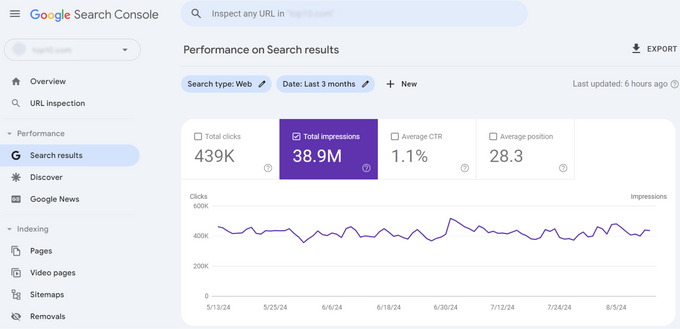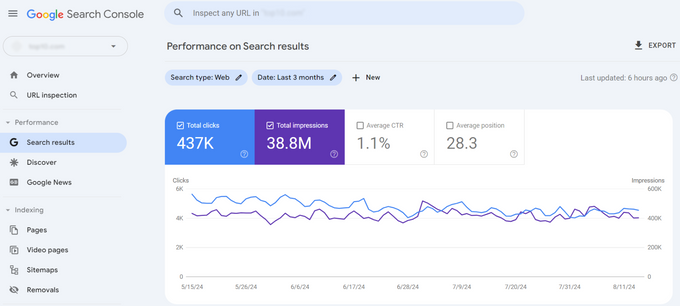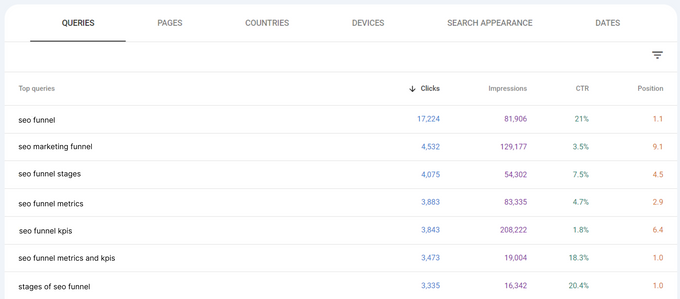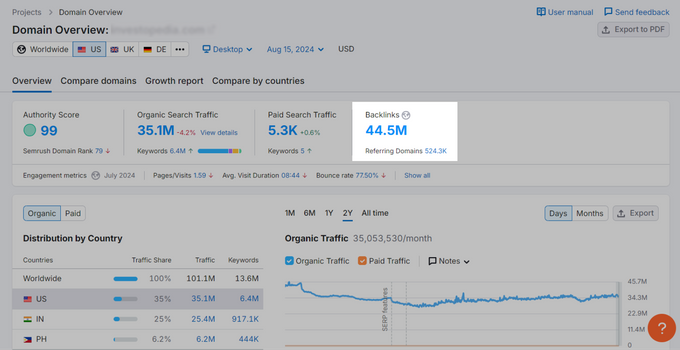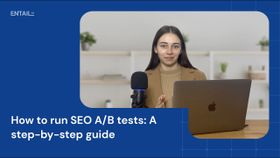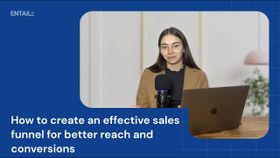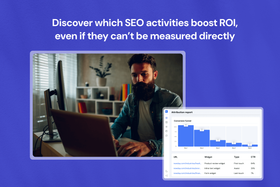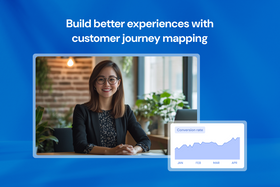4 stages of the SEO funnel: Choosing the right metrics & KPIs for each
Learn which SEO metrics and KPIs to track at each stage of the funnel and how to use them to boost your site’s performance.
Updated May 12, 2025
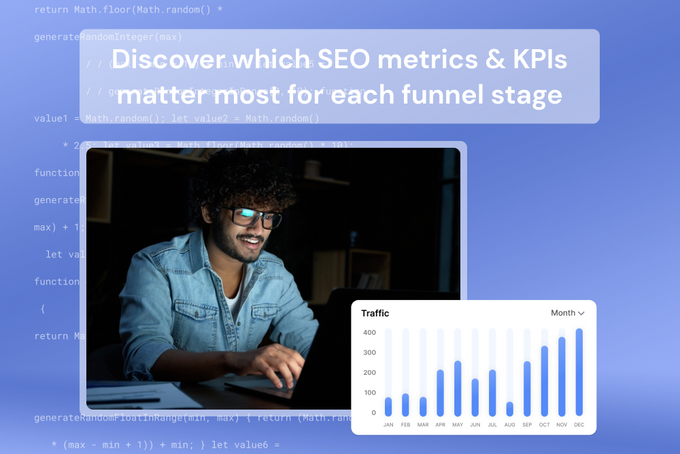
Monitoring the right SEO metrics and KPIs at each stage of the funnel is essential for driving meaningful results. However, simply tracking broad metrics like overall traffic or rankings often fails to provide the whole story. You need to focus on stage-specific metrics that reflect the user's goals and behavior at each point in the funnel to support their journey better and tailor your SEO strategies more accurately.
Let's explore the most relevant metrics and KPIs for every stage of the SEO funnel to help you create a more nuanced and effective approach to tracking and optimizing your SEO efforts.
Key takeaways
- The SEO funnel maps out the steps users take from first discovering your brand to becoming customers.
- Tracking metrics and KPIs is crucial for understanding and improving SEO.
- You should track specific SEO metrics and KPIs for each funnel stage to better understand and optimize the user journey.
- Not all SEO metrics and KPIs are relevant to your business, so choose the ones that best fit your needs.
What is the SEO funnel?
You're probably already familiar with the SEO funnel, but let's do a quick refresher before discussing those metrics.
The SEO funnel represents the path a potential customer takes on your website, from first discovering your brand to taking a desired action (like a purchase or sign-up). It guides your content creation and optimization processes, ensuring that you target users at every stage of their journey with content that converts.
The SEO funnel typically consists of four stages:
- Awareness: This is the top of the funnel where potential customers first discover your brand or product.
- Consideration: This is the middle of the funnel where potential customers research and compare products or services to decide which meets their needs.
- Conversion: This is the bottom of the funnel where customers are ready to make a purchase or complete a goal.
- Retention: This is the stage after purchase where the focus shifts to nurturing and engaging customers to encourage repeat business and build brand loyalty.
1. SEO metrics and KPIs: Awareness stage
At the top of the funnel, your main goal is to increase visibility and attract new visitors who are unfamiliar with your brand.
So, your focus should be on SEO metrics and KPIs that measure how well you capture potential customers' attention and drive organic traffic.
» Find out which content marketing KPIs you should be tracking.
Impressions
Impressions tell you how often your website appears in search results, regardless of whether the user clicks on your link. This metric is essential for understanding the visibility of your content and how well you're reaching potential audiences.
A high number of impressions indicates that your site shows up in relevant searches, which means your SEO strategy is effective. You can find this data in Google Search Console.
Keep in mind that impressions don't necessarily equate to engagement, so it's important to track other metrics as well to get a clearer picture.
Organic traffic
Organic traffic refers to the number of visitors coming to your website through search. This metric directly correlates to the success of your SEO efforts in attracting users to your site.
An increase in traffic suggests that you're targeting keywords effectively and your content is resonating with your audience. You can track organic traffic using tools like Google Search Console, Google Analytics, or SEMrush.
» Easily track the impact of your SEO efforts with Entail CRO.
Click-through rate (CTR)
Click-through rate (CTR) measures the percentage of users who click on your website after seeing it in search results. You can use CTR to understand how effective your title tags and meta descriptions are. A higher CTR means that more people are finding your listing relevant and engaging, which can positively impact your rankings.
To calculate CTR, divide the total number of clicks by the total number of impressions in a given period and multiply by 100. You can also find the CTR of your pages and queries in Google Search Console.
CTR is also relevant in the middle of the funnel or consideration stage, where measuring user engagement becomes even more critical.
Keyword rankings
Keyword rankings measure the position of your website for specific search terms in search engine results pages (SERPs). They directly indicate your website's organic search visibility and can help identify which keywords drive traffic. Improving your rankings can lead to increased organic traffic, which can translate into more leads and customers.
You can find keyword ranking data using various SEO tools like Google Search Console, SEMrush, or Ahrefs.
Non-branded searches
Non-branded searches refer to search queries that don't include your brand name but are relevant to your products or services. This metric is crucial for understanding how well you're capturing new audiences who are unfamiliar with your brand.
You can find data on non-branded searches in SEMrush or Google Search Console by filtering by queries that do not contain your brand name.
» Measure and optimize your SEO efforts with Entail CRO. Start free.
Backlinks
Backlinks are links from other websites that point to your website. They help drive organic traffic and influence your site's authority and rankings.
You can track backlinks using tools like SEMrush or Ahrefs, which provide data on the number of backlinks, their quality, and the referring domains.
To avoid penalties or indexing issues, ensure the backlinks you acquire are from reputable and relevant sites.
2. SEO metrics and KPIs: Consideration stage
Your goal at the middle of the funnel shifts to engaging visitors who are interested in your brand and considering your product or service. Here, you need data that shows how users interact with your site so that you can optimize effectively to improve user experience and encourage conversions.
Pages per session
Pages per session tracks the average number of pages a user views during a single visit to your site. A higher page per session rate suggests that visitors are interested in exploring multiple sections of your site and find your content valuable.
You can track pages per session in Google Analytics or divide your website's total page views by the total number of sessions.
Average session duration
Average session duration measures the average amount of time users spend on your website during a single session, providing insight into how engaging and relevant your content is to them. Longer average session duration generally indicates that visitors find your content valuable and, therefore, are more likely to move further down the funnel. You can use Google Analytics to track average session duration.
» Learn how to create engaging content for every funnel stage.
Micro conversions
Micro conversions are small yet significant actions that users take on your site, such as downloading a guide, signing up for a newsletter, or watching a video. These conversions can help you better understand your visitors and often lead to macro conversions.
Micro conversions provide early indicators of user intent and can help you refine your content and CTAs to meet user needs better. You can set up and track these actions in Google Analytics by adding micro conversion as an event.
» Create targeted CTAs automatically with Entail CRO.
Rate of returning visitors
The rate of returning visitors measures the percentage of users who return to your site after their first visit. A higher rate suggests that your site offers enough value to keep users coming back, increasing your chances of conversion. You can calculate the return rate by dividing the number of returning visitors by the total number of unique visitors and multiplying by 100.
Bounce rate
Bounce rate measures the percentage of visitors who leave your site after viewing only one page without taking any further action. A low bounce rate generally suggests your content is engaging and valuable to visitors.
You can find bounce rate data in most website analytics tools, such as Google Analytics. It's often displayed at the page level, allowing you to identify specific pages with high bounce rates. Alternatively, you can calculate the bounce rate by dividing the number of single-page sessions by the total number of sessions.
3. SEO metrics and KPIs: Conversion stage
At the bottom of the funnel, the focus is on turning engaged visitors into customers. You need detailed insights to help refine the final steps of the user journey and ensure that your site effectively converts interest into sales or leads.
» Learn which conversion metrics you should be tracking.
Conversions
Conversions refer to the completion of a desired action on your website, such as a purchase, form submission, or sign-up. The amount of conversions you have directly reflects how effectively your site turns visitors into customers or leads. You can track conversions with tools like Google Analytics and Entail CRO.
» Book a demo to see Entail CRO in action, or try it for free.
Conversion rate
Conversion rate is the percentage of visitors who convert out of the total number of visitors to your site. A higher conversion rate indicates that your website is effectively persuading visitors to take the next step.
You can calculate your SEO conversion rate by dividing the number of conversions by the total number of visitors and multiplying by 100. Conversion rates can vary across different channels, devices, and audience segments, so keep that in mind when identifying areas for improvement.
» Find out how to boost conversions with conversion rate optimization.
Goal completions
Goal completions refer to the number of times users complete a predefined goal on your website, such as reaching a product page, making a purchase, or filling out a form. By tracking goal completions, you can measure the effectiveness of your campaigns and optimize them for better performance. You can set up and monitor goal completions using tools like Entail CRO or Google Analytics.
Revenue per visitor (RPV)
Revenue per visitor (RPV) is the average revenue generated from each visitor to your site. This metric shows the value each visitor brings, helping you assess how well your website monetizes its traffic.
You can calculate RPV by dividing total revenue by the total number of visitors to your site. Tracking RPV allows you to identify high-value traffic sources and optimize your SEO efforts to attract more valuable visitors.
Total revenue
Total revenue measures the overall income generated from your website's sales or conversions. By tracking total revenue, you can directly correlate your SEO strategies to your business's bottom line. That said, you need to consider total revenue alongside other metrics, such as cost per acquisition and return on investment, to get a full picture of your profitability and performance.
Average order value (AOV)
Average order value (AOV) is the average amount spent each time a customer completes a transaction on your website. This helps you understand the purchasing behavior of your customers and identify opportunities to increase revenue. You can calculate AOV by dividing total revenue by the number of orders.
Cost per acquisition (CPA)
Cost per acquisition (CPA) refers to the average cost of acquiring a new customer or lead through your SEO efforts. A lower CPA indicates that you're acquiring customers more cost-effectively, which is important for maintaining a healthy profit margin.
Tracking CPA helps you optimize your marketing spend and allocate resources more effectively. You can calculate CPA by dividing the total cost of your SEO efforts by the number of acquisitions.
READ MORE: 8 ways to reduce customer acquisition costs
Return on investment (ROI)
Return on investment (ROI) calculates the profitability of your SEO efforts by comparing the revenue generated to the cost of your campaigns. A positive ROI indicates that your campaigns generate more revenue than they cost.
You can calculate SEO ROI by subtracting the investment cost from the revenue generated, dividing by the cost, and multiplying by 100. For example, if you invested $5,000 in an SEO campaign and generated $10,000 in revenue, your campaign generated a 100% ROI (($10,000 - $5,000) / $5,000 * 100).
4. SEO metrics and KPIs: Retention stage
In the retention stage, the goal is to build loyalty and encourage repeat business. Keep an eye on metrics that measure how well you retain customers so that you can enhance your SEO and marketing strategies, foster long-term relationships, and drive ongoing conversions.
Customer retention rate
Customer retention rate indicates the percentage of customers who continue to do business with your company over a specific period. A higher retention rate indicates strong customer loyalty and satisfaction, which is vital for long-term growth.
To calculate the retention rate, divide the number of customers at the end of a period by the number of customers at the start of the period and then multiply by 100.
Customer lifetime value (CLV)
Customer lifetime value (CLV), also called lifetime value (LTV) or estimated lifetime value (eLTV), estimates the total revenue you can expect from a single customer throughout your relationship. This metric can help you make informed decisions about your SEO investments and strategies.
CLV is a predictive metric that requires historical data for accurate calculations, so update your CLV calculations regularly as customer behavior and market conditions change. You may also want to consider segmenting your customer base to identify high-value customers and tailor your SEO efforts accordingly.
Repurchase ratio
The repurchase ratio tracks the percentage of customers who make more than one purchase over a given period. A higher repurchase rate indicates that customers are satisfied with their initial purchase and trust your brand enough to buy again.
You can calculate this by dividing the number of repeat customers by the total number of customers. To boost this rate, consider implementing loyalty programs, personalized offers, and excellent customer service to encourage repeat purchases.
» Struggling to keep customers engaged? Strategize with an SEO expert.
Net promoter score (NPS)
Net promoter score (NPS) measures customer loyalty by asking how likely they are to recommend your product or service to others. A higher NPS indicates strong customer loyalty and a greater likelihood of word-of-mouth referrals.
NPS is typically calculated through surveys where customers rate their likelihood to recommend your brand on a scale of 0 to 10, with scores categorized into promoters (9-10), passives (7-8), and detractors (0-6).
Customer reviews and ratings
Customer reviews and ratings, often posted on review sites, social media, or your own website, reflect your customers' feedback and satisfaction levels. This helps you understand public perception of your brand and products and influences potential customers' decisions. Positive reviews and high ratings can enhance your brand's credibility and attract new customers, while negative reviews provide valuable insights into areas needing improvement.
Measure what matters at every funnel stage
The best metrics and KPIs to monitor aren't one-size-fits-all. They depend on several factors, including your industry, business objectives, and the specific actions you want users to take at each stage. However, while not every metric may be relevant to your business, it's essential to identify and track those that align with your SEO goals. That way, you can find growth opportunities, evaluate your campaigns' performance, and make data-driven decisions that support the entire user journey while driving success at every stage of the SEO funnel.
» Book a consultation to level up your SEO strategy.
